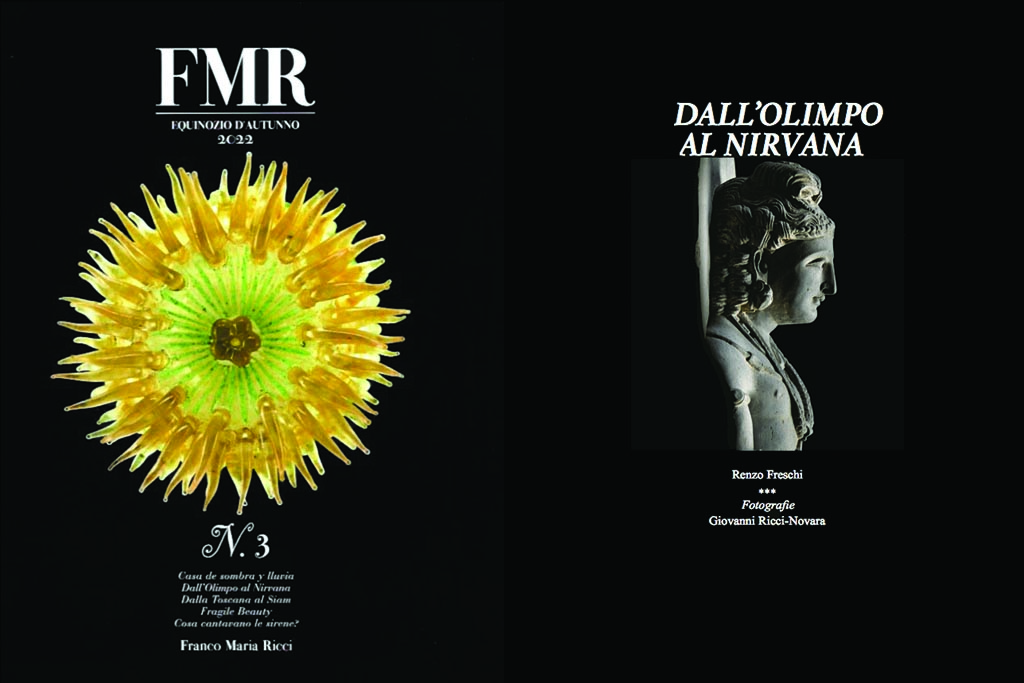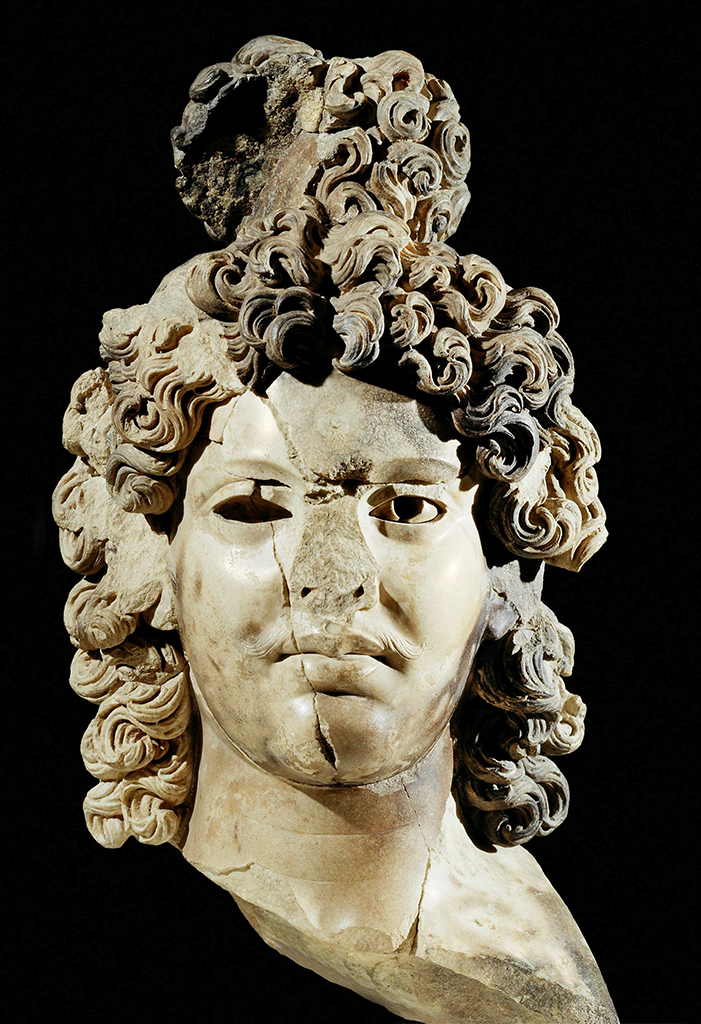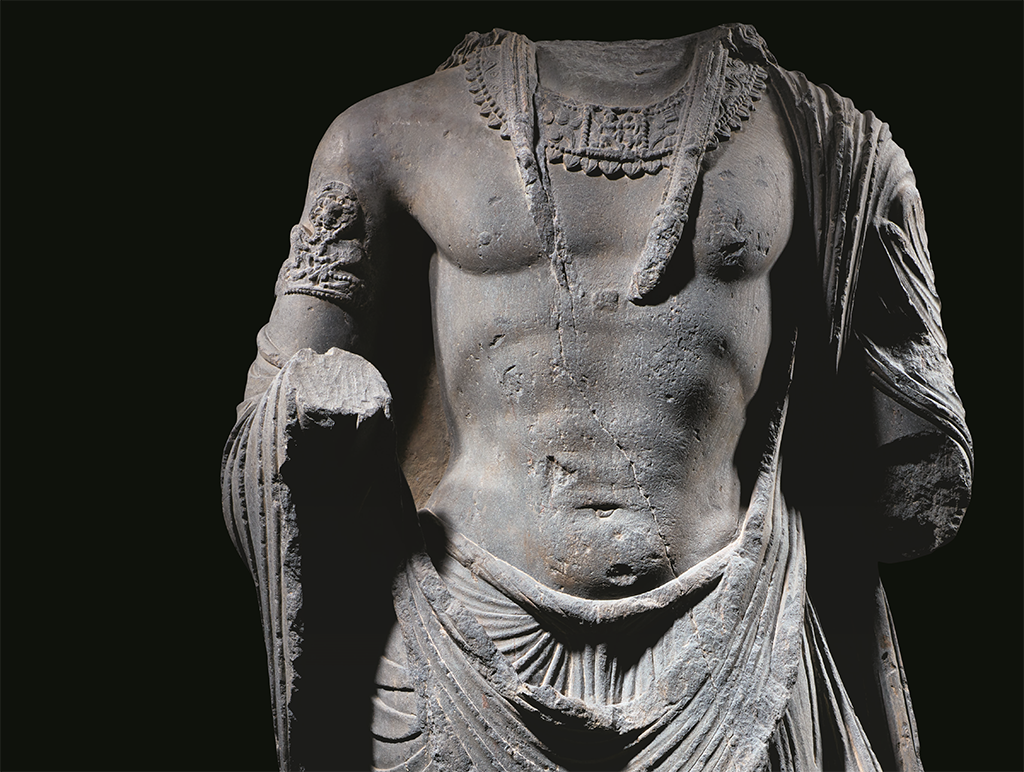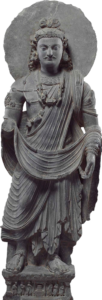
16 Sep FROM MT. OLYMPUS TO NIRVANA
Renzo Freschi
Dear Friends and Readers:
Franco Maria Ricci was one of the most refined Italian publishers, famous all over the world for the very elegant quality of his editions. In 1982 he had the idea of creating”the most beautiful magazine in the world” and FMR was the result. The publication combined printing perfection with an exclusive graphical style highlighted by distinctive photography, and often included presentations on unusual topics treated with a cultural and eccentric slant.
I was honored when FMR prososed that I write an article about the art of Gandhara for the third issue of its newly revised magazine. I tried to adapt myself to the magazine’s style with material not only from my personal knowledge, but also from the experience of voyagers, writers, and scholars who, before me, had explored and loved the places where the art of Gandhara originated–befitting the title of my article,”Apollo Met the Buddha”. This article is posted on my web site thanks to FMR’s generous copyright policy. The third issue of FMR contains also other contributions on Gandhara by renowed authors.
Happy Reading.
LOST HORIZONS
Renzo Freschi
For more than a thousand years, the art of Gandhara has been forgotten. The cities were abandoned and then destroyed and the monuments recycled as building materials for new and very different structures. The people, fervent Buddhists, eventually converted to Islam. When the curiosity of several British archeologists finally resulted in the unearthing of the first Gandhari sculptures, the astonishment was so great that it fascinated the cultural elite of all of Europe.
The Nobel laureate for literature, Rudyard Kipling (1865-1936), who was born in India and spent many years there as a young man, wrote about it in his novel Kim (1901), telling of the Lama’s and Kim’s visit to the first museum in Lahore: “In the entrance-hall stood the larger figures of the Greco-Buddhist sculptures done, savants know how long since, by forgotten workmen whose hands were feeling, and not unskillfully, for the mysteriously transmitted Grecian touch.”
The truly pioneering archeologist in India was Alexander Cunningham. He discovered ancient Taxila in 1863 and expanded his search to the Gandhara area. The brilliant young archeologist John Hubert Marshall continued his excavations and was responsible for the discovery of Harappa and Mohenjo Daro, settlements of the ancient Indus Valley Civilization (3000-1500 B.C.). His book, The Buddhist Art of Gandhara, published posthumously in 1960, was one of the earliest texts to explore the birth and development of this art in depth, but it was based on excavations done decades earlier and only on the Indian slopes of Gandhara. Marshall had seen a preponderance of Hellenistic influence in Gandhara, a theory that was subsequently called into question by new digs and discoveries. In 1919, the King of Afghanistan Amanullah Khan began a series of reforms in an attempt to modernize the country. Included in his modernization project were plans to undertake archeological digs and open the first national museum.
Standing Buddha
North Pakistan, 2nd-3rd century
Schist
Turin, Mao, Museo di Arte Orientale
Nonetheless, he was well aware that he lacked the necessary resources and in an astute move designed to distance himself equally from both Russia and England, he offered France an opportunity to carry out excavations throughout Afghanistan’s national territory. It was a political decision with extraordinary consequences, and in 1922 an official agreement was signed for an exclusive collaboration with the French Archeological Delegation. Alfred Foucher (1865-1952), one of the leading archeologists and Orientalists of the time, was put in charge. Foucher began excavating anywhere he had a hunch or had received information that he would find something, but his true guide was Xuangzang, the 7th century Buddhist monk who travelled extensively in the and had noted with great precision, “down to the millimeter,”
,” the location and appearance of the Buddhist monuments and monasteries he had visited in his Records of the Western Regions of the Great T’ang Dynasty. Foucher excavated Hadda, and it was there that he realized that the art of Gandhara was far more extensive than had previously been thought and also included a part of Afghanistan. The extraordinary sculptures that he unearthed, the Greek-style clothing that they wore, and the Apollonian faces of the Buddhas he uncovered amidst the rubble of the stupas convinced him that he was in the presence of what he termed “Greco-Buddhist” art, and that it had actually been the Greeks who had first given a human face to the Enlightened One. Foucher is still considered the father of Gandhara studies, even though his theories were partly disproved by subsequent digs.
But Afghanistan concealed even more extraordinary treasures and for several decades became the Shangri-La of archeology. The French excavations continued under very dangerous conditions, with the mullahs inciting the population against the infidels and brigands robbing a substantial portion of the finds that came to light. That was what happened at Hadda, for instance, where the most refined stucco sculptures of the Gandhari school were unearthed: Buddhas with sublime faces, portraits of an idealized beauty with seductive bodies and gazes of a profound spirituality, in some cases brightly polychromed as had been the custom in Greece.
In 1937, Ria Hackin, the daughter of the director of excavations at Angkor Wat, and her husband Joseph, a curator at the Musée Guimet, began their work at Begram, some sixty kilometers north of modern-day Kabul, which was the capital of the ancient Kingdom of Kapisa in the early centuries A.D. The first digs weren’t especially promising, but when Ria Hackin decided to change the site of the dig, she found the most magnificent treasure she could ever have dreamed of: exceedingly refined drinking glasses painted with scenes of banqueting and hunting, cobalt-blue blown glass vases, bronze statuettes of Greek and Roman provenance, Chinese lacquers, and finally a series of ivory tiles engraved with sensual Indian female figurines.
Archeological research continued in fits and starts until the 1960s, when King Mohammed Zahir Shah (1914-2007) undertook a new campaign of modernization in Afghanistan, favoring greater openness toward Europe and the United States. In 1962, while on a hunting expedition in the north of the country (ancient Bactria), the stumbled upon two Corinthian capitals that allowed the French archeologist Daniel Schlumberger to discover the ruins of the city of Ai-Khanoum atop the “Hill of the Moon”. The discovery was fundamental, because the city plan and the translation of several epigraphs led to the discovery that this was a Greek city founded at the end of the fourth century B.C. by Seleucus I Nicator, one of Alexander’s generals.
But history, as it had done in the past, once again dragged Afghanistan into a tragedy that continues even now. Viktor Sarianidi was a member of the Russo-Afghan mission undertaking excavations in Bactria, but he was neither an ideologue nor a spy: he was a great archeologist who cared only about his major discoveries. In 1978 he decided to excavate one of the hills (tepe) of the Bactrian landscape: the “Hill of the Moon,” Tillya Tepe. Working in intolerable environmental conditions, while anti-government and anti-Russian revolt broke out on all sides, Sarianidi uncovered six tombs with the bodies of five women and a man wrapped in clothing stitched with golden threads and adorned with gold jewelry of extraordinary workmanship.
The “Bactrian Hoard” consisted of over 20,000 individual items: small brooches or applied to the clothing, bracelets, clasps; pendants embossed with figures of warriors, deities, and animals, often adorned with turquoise, and coins that allowed archeologists to date the tombs to the first century of the Christian era. The grave furnishings revealed an eclectic school of art that also included Chinese, Hellenistic, and Indian elements, alongside items from the art of the steppes. The masterpieces reveal the mystery of the arrival of those nomadic hordes, who defeated the Greco-Bactrian kingdom of Ai-Khanoum and then continued toward India, where they reigned under the name of the Kushan Empire.
In 1979, the Russian army occupied Afghanistan. A war of liberation ensued and the excavations were by and large suspended; then came the Taliban who destroyed the Buddhas of Bamyan, Hadda, and half of the works in the Museum of Kabul. But all this belongs to the recent past and, sadly, is currently the way things stand today.
In 1956, the Italian government signed a treaty with Pakistan for archeological research in the ancient region of Gandhara. This was the first time since the country’s independence that a foreign mission was given such permission, and it probably took place thanks to the prestige that Giuseppe Tucci, the most famous Italian Orientalist, enjoyed on the international stage. The excavations of the Italian Archeological Mission, carried out for forty years by Domenico Faccenna, and still currently underway, concentrated on the Valley of Swat, an area with an abundance of Buddhist monuments. The results obtained through an interdisciplinary approach proved very important, and reinforced the belief that Gandhari artworks that had initially been dated between the first and fifth centuries had actually been created later, between the second and ninth centuries. Who can say whether the resumption of archeological research in a future, peaceful Afghanistan, along with new digs in Pakistan, might not lead to major new discoveries.
The Art of Gandhara
The first time I went to Kabul in 1970 and visited the National Museum of Afghanistan I was stunned by a series of statues which seemed Greek or Roman, and in my youthful ignorance I thought they were the king’s exotic collection of classical antiquities. Since then I have always tried to imagine the amazement, no doubt bigger than mine, of the archaeologists who in the mid 19th century in Pakistan’s north-west dug up from the ground after almost 2000 years statues, torsos, heads which—had it not been for the evident Buddhist content—seemed to come from the Mediterranean area. It was the art of a region once known as Gandhara.
After defeating Darius and vindicating the Greeks’ honor, Alexander the Great arrived in Bactriana to meet the Greek communities which for centuries the Achaemenids had deported from the coasts of Asia Minor in order to use them as a bulwark against barbarian invasions. At that time it was believed that Bactriana, then situated on the border of present-day Turkmenistan, Uzbekistan, Tajikistan and Afghanistan, marked the boundary of the civilized world. After overcoming hostile kingdoms, founding cities named after him, and leaving a host of garrisons, Alexander headed south, to Gandhara. But eventually, having crossed the Indus river and ready to conquer India, he had to abandon his mission to be proclaimed a god—as the mythical Dionysus had managed to do—because of the soldiers’ refusal to go on.
At that time Gandhara was a region which included part of current north-west Pakistan and of Afghanistan. Across its mountain passes (the famous Khyber among them) marched the caravans from India that were headed west to Persia and then to the Mediterranean shores; or towards the east to Bactriana and China. Following Alexander’s death the region, initially controlled by his Macedonian generals, came into the orbit of the Maurya dynasty which entrusted its administration to the local kings, thus avoiding wars and ensuring a copious tax income.
It was during this Indian dynasty that Buddhism spread into Gandhara too. Emperor Asoka’s edict of 256 BC, found near present-day Kandahar in Afghanistan and written in Greek and Aramaic, testifies to the tolerance towards citizens of Greek origin and to the presence of Buddhism, to which Asoka was a convert, well beyond the Indian frontiers. In the same century migrations of a number of ethnic groups from southern Siberia forced the Greek communities to abandon Bactriana and move to Gandhara, where the demise of the Mauryas had left a political vacuum. For about a century the Greco-Bactrian kingdoms managed to halt the barbarian hordes and also extend their control to parts of northern India.
The Greek successes were the result of an efficient military machine, but equally of cultural superiority and administrative experience. In a border region in constant confrontation with unknown and often hostile populations, the yavanas (as the Greeks were called locally) showed great adaptability: it was the combination of power, flexibility and a strong Hellenic identity that led to the birth of Gandharan art. In 140 BC the Greco-Bactrians were defeated by the Scythians and a few decades later the Parthians occupied Gandhara, marking its end as a hegemonic power. Finally, another nomadic tribe arrived who conquered present-day Afghanistan and all of northern India, becoming an imperial power: the Kusanas.
In general nomadic or “barbarian” hordes had one of two different attitudes towards the peoples and countries they invaded: they either sacked and destroyed or they often governed, assimilating the losers’ customs, as did the Kusana from the first to the third century. Kaniska (128 AD?), the most famous of Kusana sovereigns, protected Buddhism and promoted the construction of many monuments and monasteries. During the Kusana dynasty Gandhara became one of the most active centers in the spreading of the Doctrine, which missionary monks also preached in Central Asia and China. In fact, the art of Gandhara reached its full bloom under Kusana rule, and it is in this region that, in parallel with the Indian school of Mathura, the Buddha was first depicted in human form.
In the third century the Persian dynasty of the Sasanians occupied part of Afghanistan. For almost two centuries this change had no consequence on the Indian area of Gandhara—where, thanks to the protection afforded by the Indian Gupta empire, pilgrims continued to arrive and new monuments erected—but the instability of Central Asia began to hinder the traffic of trade caravans. Less tolerant were the white Huns who finally invaded the whole region and destroyed a large number of monasteries. Towards the end of the 7th century all the conditions that had allowed Gandhara to prosper (trade, pilgrimage destination, tolerance and stability) had vanished, leading to a rapid decline and to the abandonment of many urban areas. Some monastic communities survived until the 11th century, like that of Bamiyan, famous for the giant Buddhas that were destroyed by the Talibans in 2001.
Before taking a closer look at the evolution and characteristics of this art we need to address a basic issue: why were the archaeologists, who discovered it in the 19th century, all later scholars, collectors and art lovers since, so captivated? It is not hard to imagine the amazement of those who uncovered, 2500 miles from the Mediterranean shores and almost 4000 from Athens, statues with nearly identical garments to those of the ancient Greeks and faces inspired by Apollonian beauty. It is mainly this highly peculiar aspect, along with its Buddhist nature, that makes Gandharan art unique in the whole of Asia. The mix of different ethnic groups and the resources coming from the transit of goods and the masses of pilgrims were no doubt crucial to the rise of the Gandharan phenomenon, but possibly they would not have been enough without the Greek cultural element. The Hellenes who arrived on India’s threshold were the rulers of most of the then known world and belonged to a civilization that had reached levels of absolute distinction over a century earlier; the sculptors Praxiteles and Lysippos, the painter Apelles, the philosophers Demosthenes and Aristotle are Alexander’s contemporaries. After the conquest of Bactriana and Gandhara the Macedonian’s successors still possessed a strong Greek identity, as seen in the urban layout of the cities and in the production of artefacts in a clearly Hellenistic tradition.
In the 1st century AD, when the wealth and religious tolerance of the Kusana dynasty also helped a great artistic renaissance, local artisans were quick to seize this opportunity: it was the beginning of a school that would remain instantly recognizable for over 500 years.
Just as the art of Gandhara would not have come about without the contribution of Greek culture, so it would never have reached the same importance without the inspiration of Buddhism. The doctrine of the “Awakened One” (the etymological meaning of “Buddha”) is a religion that aggregates the new classes of trade and urbanization; it gives man dignity and hope regardless of caste or economic conditions. Whereas Hinduism remains linked to the rural world and to a strict social order, Buddhism is targeted at the urban classes and offers a message of tolerance and compassion which, by virtue of its universal content, spreads out well beyond the confines of India. If the Hellenistic aesthetic tradition is the form of Gandharan language, Buddhism is its content; the art of Gandhara is indeed a sacred art giving a shape to the Buddha’s message.
Maitreya sitting in the Lotus Position
North Pakistan, 2nd-3rd century, Schist
Rome, Museo dele Civiltà/Museo Nazionale di Srte Orientale “Giuseppe Tucci”
Between the first and second century AD something happens which will change the history of Buddhism: for the first time the Buddha is represented in human form. Buddha himself had said that he was not a god and that he did not want to be depicted, since the doctrine which allowed overcoming the suffering of living could not take a human form. This proscription was observed up to the early centuries of our era, when a new doctrinal school, Mahayana, tackled the issue of giving the masses of the faithful the hope of attaining Buddhahood in the course of earthly life. Until then the Enlightened One had been represented by symbols (the tree under which Sakyamuni had become a Buddha, the empty throne, the wheel of the doctrine) but whilst the symbolic language is mainly understood by the initiated, the figurative one is immediately clear to everyone, and in a phase of expansion of Buddhism it becomes a means of promotion and diffusion of the doctrine. The taboo was broken and the sculptor who first shaped the Buddha image created such a powerful icon that it established itself in almost all Asian art. Recent studies suggest that the earliest Buddha statues were first made in the Indian city of Mathura, the ancient Kusana capital, and immediately thereafter in Gandhara, more than 600 miles away. However, the debate between those who maintained that it was the Greco-Gandharans who “invented” the Buddha image (the archaeologist Alfred Foucher) and those who supported an Indian origin (Ananda K. Coomaraswamy) went on for many decades.
Right from the beginning the two schools (Hellenistic-Gandharan and Indian-Mathura) showed clear stylistic and formal differences. In general, Gandharan works looked to classical models with the addition of Indian and sometimes Iranian elements. The Buddha too is a mix of Greek and Indian features: the face is inspired by Apollonian beauty and has a Greek profile; the drapery of the monastic robe is totally Hellenistic; the eyes, the gaze, the urna (a tuft of hair between the eyebrows), the elongated earlobes and the usnisa (cranial bump) are among the somatic features linked to the Indian religious tradition which differentiate the Enlightened One from common mortals. The Buddha and the bodhisattvas also absorb characteristics from other cultures: the moustache is probably Kusana in origin, and the halo or aureole, a symbol of radiating spiritual power, belongs to the Iranian tradition. Here is another merit of Gandharan masters: they managed to create an icon mixing elements from various cultures which is easily understandable by all of them. The Mathura school prefers frontal and hieratic figures, resulting in less plasticity and a limited iconographic variety, albeit with a powerful naturalistic hallmark.
The art of Gandhara is commonly divided into two phases characterized by the use of different materials: in the first phase, 2nd to 4th century, stone (a blue-grey schist) is chiefly used, whilst in the second, late 4th to 8th century, stucco and later terracotta are preferred. Works in stone have a manifestly classical look: the drapery, the oval-shaped face with regular outlines, the slightly flexed stance of one leg enhancing the sense of plasticity, the scenes set in architectural frames with pseudo-corinthian columns and capitals, are the most obvious signs of the Greek and Roman aesthetic influence, albeit modified by local taste. From a strictly formal viewpoint Gandharan sculpture does not look to India; on account of its content it should clearly be included in textbooks of Buddhist art history, but probably not the strictly Indian one.
The classical themes, the Buddha and the most significant episodes of his earthly life are complemented by the most important figure of the Mahayana pantheon, the bodhisattva. Incarnating Buddhist compassion, the bodhisattva embodies the ideal of a human being who, once on the verge of Buddhahood, renounces supreme wisdom in order to help others on the path to Knowledge. The two images—Buddha and bodhisattva—are similar, but while the figure of the Buddha follows a strict iconographic scheme the bodhisattva retains the material symbols of his lay life: princely garments, lavish jewels and a moustache rarely to be seen on the Enlightened One’s lip.
Technically, Gandharan sculpture is closely connected with architecture. In fact the works are placed inside or outside niches and shrines, fixed to the walls with mortar, plaster and nails or tenons; the bases of stupas, the Buddhist monument par excellence, are covered in figures of various sizes and in reliefs in endless rows and multiple layers. The monuments had both a devotional and didascalic function. Alongside the statues of Buddha and bodhisattvas were reliefs illustrating episodes from the Master’s life, so that the walls became a large fresco of the Doctrine and of Buddhist values. Sculptures were usually made in low and high relief, even though the depth of volumes in the larger ones may sometimes give the impression that they are in the round.
The aim of art was not merely illustrative or celebrative, but also to strengthen the fascination of the sacred in the devotee. These psychological effects were achieved by the use of perspective and other technical means. For instance, the parts of faces and bodies in the shade are flattened and inconspicuous in order to compensate the perspective distortion caused by the fact of observing them from a lower or lateral position. The disproportion between the main figure and the lateral ones in large high-reliefs was the result of a proportional symbolism which enlarged the Buddha and bodhisattvas and made secondary figures smaller—above all devotees and princes—based on hierarchic and spiritual criteria.
Between the 4th and 6th century the demand grows for sculptures and reliefs as decoration for the many stupas, commissioned as evidence of a pilgrimage and as a sign of devotion. The use of stucco (a mixture of quicklime, water and other materials to make it stronger) is a more than satisfactory answer to the strong demand for images, it is easier to work than schist and also cheaper since it requires less time and labor. Stucco can also be modeled with molds, enabling replication of the same object; it is the beginning of series production in which decorative elements are molded to then be carefully hand-finished, assembled and installed in religious buildings. The use of a plastic material (a tradition coming from Alexandria in Egypt, and from Palmyra in Syria) is so successful that it replaces stone. Sculptures are often painted in bright colors in order to highlight the preciousness of garments and ornaments; eyes and lips are marked by strong lines giving the face volume and expression; the Buddha’s face is sometimes gilded. The result, no doubt compelling, was much appreciated by the taste of the time and it can be observed in those works that have partially or fully preserved the original polychromy. Stucco sculpture is characterized by a smaller number of themes and subjects compared to stone. The tendency to increase dimensions of the images, up to some yards tall, and to giant pieces, like for instance the 180 ft tall Buddha in Bamiyan (Afghanistan), confirms the will to emphasize the ecumenic power of the Buddha figure. This certainly implies a deep knowledge of psychology of communication, in which simplification and duplication of the message-icon makes it more easily understandable and reinforces its communication power. In other words, the larger and more widespread the image of the Buddha, the more effective its message. Production in stucco is no longer characterized by the stiffness of works of stone and it tends to reappropriate Hellenistic-Roman aesthetic canons. The figures reveal a supple and soft modelling, even if at the expense of the rich pleating of those of stone. The bodies have a more idealized than human realism. The face becomes more oval-shaped and acquires volume; the Buddha’s face has a detached, inwardly turned gaze. Stone and stucco seem to elicit different psychologic reactions in the observer: stronger and more solemn for stone, more akin to suggestion and sentiment for stucco.
Among the materials used in sculpture, terracotta appears later than schist and stucco, but it allows making larger statues and more articulated narrative compositions. Furthermore the material is easily malleable and the sculptor can create more realistic and often strongly expressionistic works. Where environmental conditions did not permit the use of stone and stucco, like in isolated monastic communities, it was easier to cut cells and shrines into the mountain face. The holy images were often made of raw or fired clay as in the Dunhuang caves, in Chinese Xinjiang and probably at Bamiyan, where however only a few frescos survive. Decidedly rarer than the others, terracotta sculptures are also different in style and in the subjects depicted. Unfortunately, no specific literature exists on Gandharan terracotta art, and even scholarly texts have little to offer, mainly heads and rarely complete figures. They were probably part of large devotional scenes in which the Buddha was surrounded by bodhisattvas, gods, kings, soldiers and simple devotees, each with his own peculiar traits: a three-dimensional fresco of divine beings and various humans.
What emerges from these faces is portraitural research, as if the artists had chosen this material in order to express their creativity without iconographic restrictions, free to emphasize the individual character of the people. While schist and stucco heads seem to conform to a model which is replicated with little variation, those of terracotta show an extraordinary variety of types, no two being identical or even similar. It is virtually impossibile to establish a precise chronology of the works; just six or seven schist sculptures are dated and very few epigraphic and historical sources are available. For about five centuries the art of Gandhara preserved a certain aesthetic conformance with its origins and did not experience the usual slow decline, with the consequent production of “late” works. When the destruction wrought by the invaders and the disappearance of Buddhism in India sapped the economy of the region, artistic production rapidly followed suit. Gandharan reminiscences remained until the 8th/9th century in Indian Kashmir and in that vast portion of Central Asia called Serindia, but these works, regardless of their aesthetic value, do not constitute the true art of Gandhara.

Head of Prince Siddharta (?), North Pakistan, 2nd century, Marble
Geneva, George Ortiz Collection
Foto Eric Lessing/Album/Mondadori/Porfolio












John Vincent Bellezza
Posted at 04:54h, 09 OctoberEnjoyed your article.
John Vincent Bellezza
Posted at 04:54h, 09 OctoberEnjoyed your article.